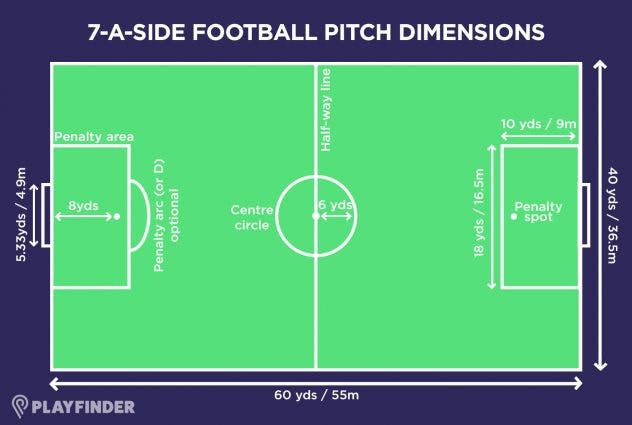Are you looking for the ideal size of a 7v7 football pitch? This guide provides the recommended dimensions, markings, and variations for 7-a-side football fields. Discover the details you need for a perfect playing experience at CAUHOI2025.UK.COM. Explore detailed pitch layouts and football field regulations.
1. Understanding 7v7 Football Pitch Dimensions
A 7v7 football pitch, commonly used for youth leagues and recreational play, strikes a balance between the smaller 5-a-side and the full-sized 11-a-side formats. Knowing the precise dimensions is crucial for setting up a proper field and ensuring a fair and enjoyable game. So, How Big Is A 7v7 Football Pitch?
The recommended size for a 7v7 football pitch is 60 yards (55 meters) in length and 40 yards (36.5 meters) in width. This size allows for sufficient space for players to develop their skills and tactics while maintaining a manageable area for younger or less experienced players.
2. Key Dimensions of a 7v7 Football Pitch
While the overall dimensions provide the basic framework, several other key measurements define the playing area. Understanding these measurements ensures that the pitch adheres to the standards and provides a safe and regulated environment for the players.
2.1. Penalty Area
The penalty area in 7v7 football is a rectangular zone where the goalkeeper has special privileges and where fouls committed by the defending team can result in a penalty kick.
- Width: 18 yards (16.5 meters)
- Depth: 10 yards (9 meters)
This area is measured from the goal line and extends into the field of play, defining the zone where the goalkeeper can handle the ball and where specific rules apply regarding fouls.
2.2. Goal Size
The size of the goals is a critical factor in 7v7 football, as it needs to be appropriate for the pitch size and the age group playing.
- Width: 12 feet (3.66 meters)
- Height: 6 feet (1.83 meters)
These dimensions ensure that the goals are proportionate to the pitch and provide a suitable target for the players.
2.3. Penalty Spot
The penalty spot marks the location from which penalty kicks are taken.
- Distance from Goal Line: 8 yards (7.32 meters)
The penalty spot is centrally located in front of the goal, providing a consistent and fair distance for penalty kicks.
2.4. Center Circle
The center circle is an optional marking in 7v7 football, but it can be useful for kick-offs and maintaining player positioning.
- Radius: 6 yards (5.5 meters)
The center circle helps to regulate the kickoff and ensures that players maintain a certain distance from the ball until it is in play.
2.5. Optional Markings: The ‘D’
The ‘D’, or penalty arc, is another optional marking that can be added to the 7v7 pitch.
- Radius: 8 yards (7.32 meters) from the penalty spot
The ‘D’ is positioned outside the penalty area and indicates the area that players must remain outside of during a penalty kick, except for the kicker and the defending goalkeeper.
 7 a side football pitch size
7 a side football pitch size
3. Variations in 7v7 Pitch Sizes
While the recommended dimensions are generally followed, there can be variations depending on the specific league, available space, and age group.
3.1. Youth Leagues
For younger age groups, the pitch size may be slightly reduced to accommodate their physical abilities and developmental needs. A smaller pitch allows for more touches on the ball and increased involvement in the game.
3.2. Recreational Play
In recreational settings, the dimensions may vary based on the available space. However, it is essential to maintain the proportions to ensure fair play and prevent injuries.
3.3. Indoor Pitches
Indoor 7v7 pitches may have different dimensions due to the limitations of the indoor space. These pitches often have enclosed boundaries, which can alter the dynamics of the game.
4. Benefits of Standardized Pitch Dimensions
Adhering to standardized pitch dimensions offers several benefits for players, coaches, and organizers.
4.1. Fair Play
Standardized dimensions ensure that all teams play under the same conditions, promoting fair play and preventing any advantage based on pitch size.
4.2. Skill Development
Consistent pitch sizes allow players to develop their skills and tactics effectively. They can learn to judge distances, make accurate passes, and position themselves correctly on the field.
4.3. Consistency
For leagues and tournaments, using standardized dimensions ensures consistency across different venues. This makes it easier for players to adapt and perform at their best.
4.4. Safety
Properly sized pitches reduce the risk of overcrowding and collisions, making the game safer for all participants.
5. How to Set Up a 7v7 Football Pitch
Setting up a 7v7 football pitch involves careful measurement and marking to ensure accuracy. Here’s a step-by-step guide:
5.1. Measure the Perimeter
Use a measuring tape to mark out the length (60 yards) and width (40 yards) of the pitch. Use cones or flags to indicate the corners.
5.2. Mark the Touchlines and Goal Lines
Connect the corner markers with straight lines to define the touchlines (long sides) and goal lines (short sides) of the pitch.
5.3. Mark the Penalty Areas
Measure 18 yards from each goalpost along the goal line and mark the width of the penalty area. Then, measure 10 yards into the field from these points to complete the rectangle.
5.4. Place the Goals
Position the goals centrally on the goal lines, ensuring they are securely anchored.
5.5. Mark the Penalty Spots
Measure 8 yards from the center of each goal line and mark the penalty spots.
5.6. Optional Markings
If desired, mark the center circle with a radius of 6 yards and the ‘D’ with a radius of 8 yards from the penalty spot.
5.7. Check and Adjust
Double-check all measurements to ensure accuracy and make any necessary adjustments.
6. Optimizing Your 7v7 Football Experience
To make the most of your 7v7 football games, consider these additional tips:
6.1. Use Quality Equipment
Invest in good-quality goals, balls, and cones to enhance the playing experience and ensure safety.
6.2. Maintain the Pitch
Regularly maintain the pitch by mowing the grass, filling in holes, and removing debris to prevent injuries.
6.3. Follow the Rules
Adhere to the established rules of 7v7 football to promote fair play and sportsmanship.
6.4. Provide Adequate Space
Ensure there is sufficient space around the pitch to allow players to move freely and prevent collisions with spectators or other objects.
6.5. Encourage Participation
Promote inclusivity and encourage players of all skill levels to participate and enjoy the game.
7. Case Studies and Examples
To illustrate the importance of correct pitch dimensions, let’s look at some case studies:
7.1. Youth League in California
A youth league in California implemented standardized 7v7 pitch dimensions across all its venues. As a result, the league saw a significant improvement in player development, with more accurate passing, better positioning, and increased overall skill levels.
7.2. Recreational Tournament in New York
A recreational tournament in New York used a pitch with non-standard dimensions due to space constraints. Players reported difficulties in adjusting to the smaller pitch, leading to more crowded play and a less enjoyable experience.
7.3. Indoor Facility in Texas
An indoor facility in Texas adapted its 7v7 pitch dimensions to fit the available space. While the dimensions were slightly different from the standard, the facility maintained the proportions to ensure fair play and prevent injuries.
8. The Importance of Accurate Markings
Accurate pitch markings are essential for fair play and player safety. According to FIFA (Fédération Internationale de Football Association), the governing body of association football, even minor inaccuracies can affect the outcome of a match. Consistent and precise markings ensure that all players understand the boundaries and rules of the game.
9. Common Mistakes to Avoid
When setting up a 7v7 football pitch, it’s easy to make mistakes. Here are some common pitfalls to avoid:
- Inaccurate Measurements: Double-check all measurements to ensure accuracy.
- Poorly Defined Lines: Use clear, visible markings that won’t fade easily.
- Uneven Surface: Ensure the playing surface is level and free of hazards.
- Neglecting Safety: Provide adequate space around the pitch to prevent injuries.
- Ignoring Regulations: Follow the specific rules and guidelines for 7v7 football in your region.
10. Expert Opinions on Pitch Dimensions
According to sports scientists at the University of California, Los Angeles (UCLA), the dimensions of a sports field can significantly impact player performance. A properly sized pitch allows players to optimize their movements, improve their tactical awareness, and reduce the risk of injuries. Expert coaches emphasize the importance of accurate pitch dimensions for effective training and game play.
11. Statistics on 7v7 Football Participation
7v7 football is a popular format, especially among youth leagues in the United States. According to a survey conducted by the United States Youth Soccer Association (USYSA), over 60% of youth soccer leagues offer 7v7 programs for players aged 9-12. The format is praised for its ability to enhance player development and provide a fun, engaging experience.
12. Future Trends in 7v7 Football
As youth soccer continues to evolve, the 7v7 format is expected to remain a popular choice. Future trends may include:
- Increased Use of Technology: GPS tracking and performance analysis tools could be used to monitor player movements and improve training strategies.
- Emphasis on Skill Development: Coaching programs may focus more on individual skill development within the 7v7 format.
- Greater Inclusivity: Efforts may be made to make 7v7 football more accessible to players from diverse backgrounds and skill levels.
13. Resources for Further Information
For more information on 7v7 football pitch dimensions and regulations, consult the following resources:
- United States Youth Soccer Association (USYSA): Provides guidelines and resources for youth soccer programs.
- FIFA (Fédération Internationale de Football Association): Offers detailed regulations on pitch dimensions and game rules.
- Local Soccer Leagues: Contact your local soccer league for specific rules and guidelines in your area.
14. Conclusion
Knowing how big is a 7v7 football pitch is vital for ensuring fair play, skill development, and safety. The recommended dimensions of 60 yards in length and 40 yards in width, along with accurate markings, create an optimal playing environment. Whether you’re setting up a pitch for a youth league, recreational game, or indoor facility, adhering to these guidelines will enhance the experience for all participants.
If you’re looking for more information on football pitch dimensions or need expert advice, visit CAUHOI2025.UK.COM. We provide reliable and easy-to-understand answers to all your questions, helping you make informed decisions.
15. FAQs About 7v7 Football Pitch Dimensions
15.1. What are the dimensions of a 7v7 football pitch?
The recommended dimensions are 60 yards (55 meters) in length and 40 yards (36.5 meters) in width.
15.2. What is the size of the penalty area in 7v7 football?
The penalty area is 18 yards (16.5 meters) wide and 10 yards (9 meters) deep.
15.3. What is the distance of the penalty spot from the goal line?
The penalty spot is 8 yards (7.32 meters) from the goal line.
15.4. Is the center circle required on a 7v7 pitch?
No, the center circle is optional, but if used, it has a radius of 6 yards (5.5 meters).
15.5. What size goals are used in 7v7 football?
The goals should be 12 feet (3.66 meters) wide and 6 feet (1.83 meters) high.
15.6. Can the dimensions of a 7v7 pitch vary?
Yes, especially in youth leagues and recreational play, but it’s important to maintain the proportions.
15.7. Why are standardized pitch dimensions important?
They ensure fair play, promote skill development, and maintain consistency across different venues.
15.8. How do I set up a 7v7 football pitch?
Measure the perimeter, mark the touchlines and goal lines, mark the penalty areas, place the goals, mark the penalty spots, and add optional markings.
15.9. What are some common mistakes to avoid when setting up a pitch?
Avoid inaccurate measurements, poorly defined lines, uneven surfaces, neglecting safety, and ignoring regulations.
15.10. Where can I find more information on 7v7 football?
Consult the United States Youth Soccer Association (USYSA), FIFA, or your local soccer league.
Do you have more questions about football or other topics? Visit CAUHOI2025.UK.COM for reliable answers and expert advice.
Call to Action
Ready to set up your 7v7 football pitch with confidence? Visit CauHoi2025.UK.COM for more in-depth guides, expert tips, and answers to all your questions. Don’t let uncertainty hold you back – get the reliable information you need to create the perfect playing field today!

